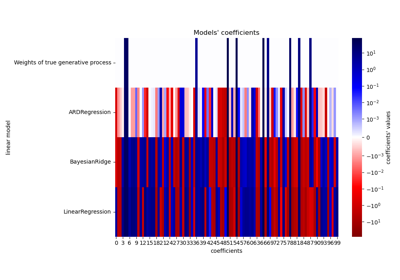-
class sklearn.linear_model.ARDRegression(n_iter=300, tol=0.001, alpha_1=1e-06, alpha_2=1e-06, lambda_1=1e-06, lambda_2=1e-06, compute_score=False, threshold_lambda=10000.0, fit_intercept=True, normalize=False, copy_X=True, verbose=False)[source] -
Bayesian ARD regression.
Fit the weights of a regression model, using an ARD prior. The weights of the regression model are assumed to be in Gaussian distributions. Also estimate the parameters lambda (precisions of the distributions of the weights) and alpha (precision of the distribution of the noise). The estimation is done by an iterative procedures (Evidence Maximization)
Read more in the User Guide.
Parameters: n_iter : int, optional
Maximum number of iterations. Default is 300
tol : float, optional
Stop the algorithm if w has converged. Default is 1.e-3.
alpha_1 : float, optional
Hyper-parameter : shape parameter for the Gamma distribution prior over the alpha parameter. Default is 1.e-6.
alpha_2 : float, optional
Hyper-parameter : inverse scale parameter (rate parameter) for the Gamma distribution prior over the alpha parameter. Default is 1.e-6.
lambda_1 : float, optional
Hyper-parameter : shape parameter for the Gamma distribution prior over the lambda parameter. Default is 1.e-6.
lambda_2 : float, optional
Hyper-parameter : inverse scale parameter (rate parameter) for the Gamma distribution prior over the lambda parameter. Default is 1.e-6.
compute_score : boolean, optional
If True, compute the objective function at each step of the model. Default is False.
threshold_lambda : float, optional
threshold for removing (pruning) weights with high precision from the computation. Default is 1.e+4.
fit_intercept : boolean, optional
whether to calculate the intercept for this model. If set to false, no intercept will be used in calculations (e.g. data is expected to be already centered). Default is True.
normalize : boolean, optional, default False
If True, the regressors X will be normalized before regression. This parameter is ignored when
fit_interceptis set to False. When the regressors are normalized, note that this makes the hyperparameters learnt more robust and almost independent of the number of samples. The same property is not valid for standardized data. However, if you wish to standardize, please usepreprocessing.StandardScalerbefore callingfiton an estimator withnormalize=False.copy_X : boolean, optional, default True.
If True, X will be copied; else, it may be overwritten.
verbose : boolean, optional, default False
Verbose mode when fitting the model.
Attributes: coef_ : array, shape = (n_features)
Coefficients of the regression model (mean of distribution)
alpha_ : float
estimated precision of the noise.
lambda_ : array, shape = (n_features)
estimated precisions of the weights.
sigma_ : array, shape = (n_features, n_features)
estimated variance-covariance matrix of the weights
scores_ : float
if computed, value of the objective function (to be maximized)
Notes
See examples/linear_model/plot_ard.py for an example.
Examples
>>> from sklearn import linear_model >>> clf = linear_model.ARDRegression() >>> clf.fit([[0,0], [1, 1], [2, 2]], [0, 1, 2]) ... ARDRegression(alpha_1=1e-06, alpha_2=1e-06, compute_score=False, copy_X=True, fit_intercept=True, lambda_1=1e-06, lambda_2=1e-06, n_iter=300, normalize=False, threshold_lambda=10000.0, tol=0.001, verbose=False) >>> clf.predict([[1, 1]]) array([ 1.])Methods
decision_function(\*args, \*\*kwargs)DEPRECATED: and will be removed in 0.19. fit(X, y)Fit the ARDRegression model according to the given training data and parameters. get_params([deep])Get parameters for this estimator. predict(X)Predict using the linear model score(X, y[, sample_weight])Returns the coefficient of determination R^2 of the prediction. set_params(\*\*params)Set the parameters of this estimator. -
__init__(n_iter=300, tol=0.001, alpha_1=1e-06, alpha_2=1e-06, lambda_1=1e-06, lambda_2=1e-06, compute_score=False, threshold_lambda=10000.0, fit_intercept=True, normalize=False, copy_X=True, verbose=False)[source]
-
decision_function(*args, **kwargs)[source] -
DEPRECATED: and will be removed in 0.19.
Decision function of the linear model.
Parameters: X : {array-like, sparse matrix}, shape = (n_samples, n_features)
Samples.
Returns: C : array, shape = (n_samples,)
Returns predicted values.
-
fit(X, y)[source] -
Fit the ARDRegression model according to the given training data and parameters.
Iterative procedure to maximize the evidence
Parameters: X : array-like, shape = [n_samples, n_features]
Training vector, where n_samples in the number of samples and n_features is the number of features.
y : array, shape = [n_samples]
Target values (integers)
Returns: self : returns an instance of self.
-
get_params(deep=True)[source] -
Get parameters for this estimator.
Parameters: deep : boolean, optional
If True, will return the parameters for this estimator and contained subobjects that are estimators.
Returns: params : mapping of string to any
Parameter names mapped to their values.
-
predict(X)[source] -
Predict using the linear model
Parameters: X : {array-like, sparse matrix}, shape = (n_samples, n_features)
Samples.
Returns: C : array, shape = (n_samples,)
Returns predicted values.
-
score(X, y, sample_weight=None)[source] -
Returns the coefficient of determination R^2 of the prediction.
The coefficient R^2 is defined as (1 - u/v), where u is the regression sum of squares ((y_true - y_pred) ** 2).sum() and v is the residual sum of squares ((y_true - y_true.mean()) ** 2).sum(). Best possible score is 1.0 and it can be negative (because the model can be arbitrarily worse). A constant model that always predicts the expected value of y, disregarding the input features, would get a R^2 score of 0.0.
Parameters: X : array-like, shape = (n_samples, n_features)
Test samples.
y : array-like, shape = (n_samples) or (n_samples, n_outputs)
True values for X.
sample_weight : array-like, shape = [n_samples], optional
Sample weights.
Returns: score : float
R^2 of self.predict(X) wrt. y.
-
set_params(**params)[source] -
Set the parameters of this estimator.
The method works on simple estimators as well as on nested objects (such as pipelines). The latter have parameters of the form
<component>__<parameter>so that it?s possible to update each component of a nested object.Returns: self :
-
linear_model.ARDRegression()
Examples using
2025-01-10 15:47:30

Please login to continue.